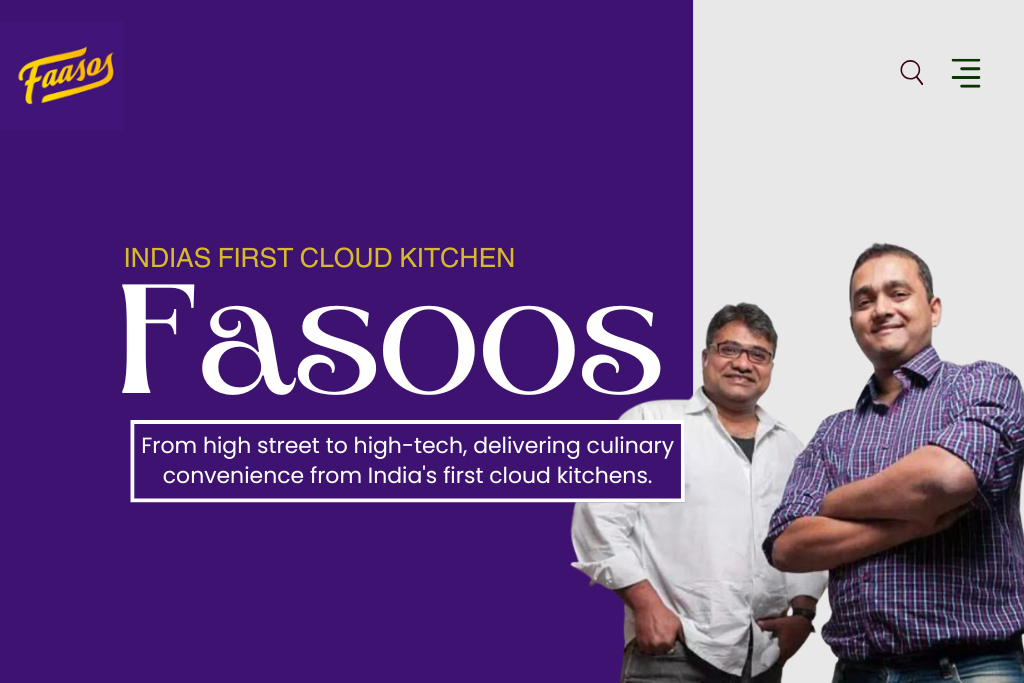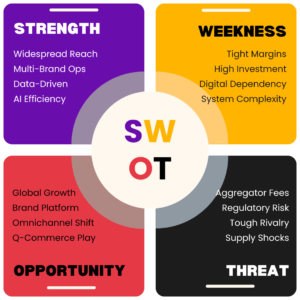How Faasos Built India’s First Cloud Kitchen Empire with Smart Branding

Ever wondered how a craving for Kolkata rolls ignited India’s cloud kitchen revolution and spawned the Faasos empire?
The Origin Story of Faasos
In 2011, Jaydeep Barman an ex-McKinsey consultant with a taste for genuine Calcutta rolls found himself sipping rum and cola in his Pune apartment, lamenting, “Why can’t I order real Kolkata rolls on delivery?”
Thus, Faasos was born: a one-man kitchen experiment with a bold mission that was to become India’s first ₹1,000 crore cloud-kitchen empire, serving biryani, wraps, dosa, and more, all without a single dine-in table.
“McKinsey was terrific, but building a kitchen was closer to our hearts.” — Jaydeep Barman
“Here, we never emulate; we break new ground every day.” — Kallol Banerjee
Act I: The Pressure Cooker (Fassos 2014)
By 2014, Faasos had grown to 50 outlets but was bleeding cash and running half-empty kitchens paying steep high-street rents while generating just half the orders needed for breakeven. Despite ₹27 crore in sales that year, losses hit ₹15 crore, and by FY16 revenues of ₹62 crore came with a ₹111 crore loss as expansion costs and rent ate into every rupee of growth.
Key crises converged:
- Only 50% kitchen utilization meant empty ovens and wasted staff.
- Rent consumed 20% of sales—well above the sustainable 10–15% range.
- Legacy POS and Tally systems blocked real-time data, inflating maintenance and hiring costs.
- App downloads hit 0.8 million but 74% never stepped into a store, exposing a gap between digital reach and physical sales.
Surveys revealed 76% of customers ordered without visiting any outlet, proving delivery demand far outstripped dine-in. Yet delivery economics were dire: discounts and delivery fees wiped out the margins, and each delivery executive needed to move ₹10,000 worth of food daily just to cover a ₹25,000 salary.
Could Faasos ditch high-street costs and conquer delivery before burning out?
Act II: The Transformation Trilogy
In late 2015, Faasos arrived at a crossroads: sprawling dine-in outlets were draining cash and cluttering strategy. The first daring act of transformation reshaped the company’s destiny.
Cloud-Only Kitchens
Armed with customer data proving 76% of orders came without a store visit, Faasos quietly closed its dine-in spaces and converted them into invisible “dark kitchens.” Overnight, the brand:
- Slashed rent and staffing costs by roughly 30%, trimming fixed overheads from day one.
- Packed multiple sub-brands—wraps, biryanis, pizzas—into each facility, turning a single kitchen into 6–8 virtual restaurants.
- Lifted kitchen utilization from a wasteful 50% to an efficient 60–70% within just twelve months.
Key Insight: When every square foot earns its keep, margins expand naturally.
Tech Stack Overhaul (2016–2020)
With real estate optimized, Faasos tackled chaotic operations next. A unified ERP and cloud migration became the backbone of its scale:
- ERP Unification: In nine intense months, Sage 300 went live across 75 kitchens, slashing reconciliation errors by 90% and freeing managers to focus on growth.
- AWS Migration: A move to auto-scaling infrastructure absorbed three times the traffic on New Year’s Eve without a hiccup, cutting order-to-chef latency by 25%.
- Data-Driven Culture: Weekly “pulse” dashboards—tracking time-to-cook, on-time delivery, waste rates—became ritual, aligning 1,000+ staff around shared goals.
Key Insight: A single source of truth turns chaotic expansion into deliberate scale.
AI & Engagement Mastery (Faasos 2020–2024)
The final act fused artificial intelligence with real-time engagement to plug profit leaks:
- SWAT Visual-AI QA: IoT cameras inspected portion size, temperature, and plating, driving wastage down from 3% to under 0.5%—an annual savings of ₹92 crore, dwarfed by the ₹15 crore hardware investment.
- CleverTap Journeys: Automated, context-aware push campaigns snagged customers who abandoned carts, boosting conversions by 7 percentage points (~3,500 extra orders monthly) and raising click-through rates from 12% to 15.6%.
Key Insight: Rigorous AI-driven quality control paired with timely reengagement turns every operational leak into fresh revenue.
Together, these three revolutionary steps recast Faasos from a cost-heavy QSR chain into a nimble, data-powered food-tech pioneer—today known as Rebel Foods—poised to lead India’s delivery-only dining frontier.
The Financial Crescendo of Faasos
Revenue soared 2.5× while losses narrowed 15%, proving disciplined tech bets drive profitable expansion.

From the outset, Rebel Foods wielded scale as its superpower—a sprawling network of cloud kitchens that juggle multiple beloved brands under one roof. This multi-brand model isn’t just clever real estate wizardry; it’s a masterclass in efficiency, driving down costs while pushing up speed and variety.
Yet every hero’s tale has its challenges. Rebel operates on razor-thin margins in a hyper-competitive delivery arena, and its appetite for cutting-edge tech and automation comes with hefty upfront costs. Add in a heavy reliance on Zomato, Swiggy, and other digital platforms—and the complex dance of multiple software systems—and you see the tightrope Rebel walks every day.
But where others see obstacles, Rebel spots opportunities. The rise of 15-minute quick commerce is a new frontier, ready to expand its total addressable market. Overseas horizons in MENA, the UK, and Southeast Asia beckon, promising fresh chapters in Rebel’s global growth story. And with the Rebel Launcher platform, third-party brands can tap into Rebel’s kitchen magic, turning infrastructure into a revenue goldmine.
Still, the plot thickens. Aggregator commissions threaten to nibble away profits, regulatory audits by food-safety bodies loom, and supply-chain shocks can rattle even the sturdiest kitchen. New challengers—like Curefoods and FreshMenu—stand ready to disrupt.
Through it all, Rebel Foods blends data obsession, real-time dashboards, and AI-powered quality checks that slashed waste by 75%. Their secret ingredient? A relentless drive to innovate. Whether through omnichannel pivots marrying cloud and physical presence or harnessing AI for smarter operations, Rebel’s mission is clear: serve the future of dining, faster, greener, and more deliciously than ever.
Scaling Horizons
By 2022, Rebel Foods commanded 450+ kitchens in 75 cities across India, MENA, UK, and SEA—operating 11 brands under one digital roof and raising $175 M Series F at $1.4 B valuation (Oct ’21) and $210 M Series G led by Temasek (Dec ’24).
Takeaway for Aspiring Entrepreneurs
- Audit with Precision: Translate every drop of abandonment, idle capacity, and wastage into rupee terms to expose hidden drains on profit.
- Consolidate from Day One: A unified ERP and cloud backbone aren’t luxuries—they’re the bedrock for scalable efficiency.
- Automate Strategically: Deploy AI-driven workflows and engagement platforms to capture every incremental rupee and eliminate manual leakages.
- Measure at Every Level: Monitor micro-metrics (revenue upticks, per-order savings) alongside macro-outcomes (overall cost reduction, margin expansion) to guide agile pivots.
The Faasos saga proves that fusing culinary mastery with full-stack technology—and an unyielding obsession with ROI—drives exponential gains. Hunt down your largest “wastes,” automate without mercy, and watch your own empire soar.
Now the question for you is can Rebel Foods replicate its cloud-kitchen magic in Western markets without losing its scrappy soul?
